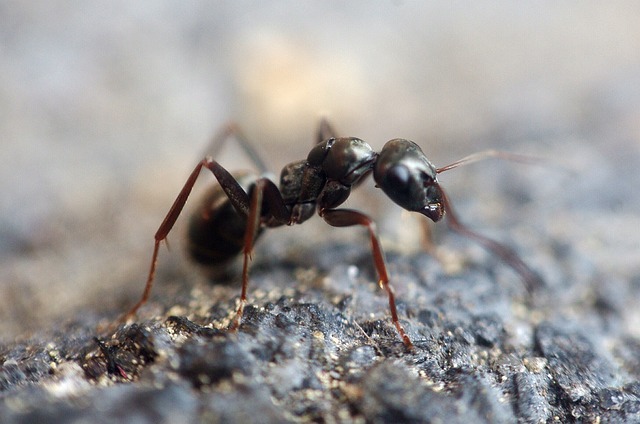Ants' trail systems, built through pheromone communication, pose both challenges and opportunities for ant control services. Understanding these chemical signals allows researchers to develop innovative solutions like specialized traps and repellents. Advanced technologies such as surveillance systems, sensors, remote sensing, and artificial intelligence are transforming ant management, offering more precise, eco-friendly methods that minimize chemical use. While these techniques provide significant advantages like enhanced efficiency and data-driven mapping, they also present challenges like resource investment and potential risks to non-target species, requiring careful balance for effective, sustainable, and responsible ant control services.
Ant trails, invisible networks leaving a chemical trail, pose challenges in both residential and commercial settings. Traditional ant control methods, while effective, are often reactive and rely on chemicals with potential environmental impacts. This article explores innovative technologies revolutionizing ant control services. From scent detection dogs to remote sensing drones and AI-driven analysis, these advancements offer more precise, efficient, and eco-friendly solutions for identifying and treating ant trails, transforming the way we manage these persistent pests.
Understanding Ant Trails: The Behavior and Chemistry Behind Them
Ant trails, left behind by these relentless creatures, are more than just a nuisance; they’re intricate chemical signals that guide their colonies. Understanding this behavior is key to developing effective ant control services. Ants communicate through pheromones, leaving a scent trail that attracts others to food sources. Each ant leaves a tiny amount of pheromone as it moves, creating a visible and invisible path for its fellow ants to follow.
These trails can form complex networks, especially in urban areas where food is abundant. The chemistry behind them is fascinating; ants produce different pheromones for various purposes, such as marking paths, recruiting workers, or signaling danger. By studying these chemical cues, researchers can develop innovative technologies like specialized traps and repellents that disrupt ant trails without harming the environment, offering a more sustainable approach to ant control services.
Traditional vs. Innovative Ant Control Methods
In the realm of ant control services, traditional methods have long relied on chemical pesticides and manual removal, which often present limited and short-lived solutions. However, innovative technologies are transforming the way we address ant trails and infestations. These cutting-edge approaches offer more effective, eco-friendly, and precise strategies to manage these persistent pests.
One such innovation is the use of advanced surveillance systems and sensors that detect ant activity in real time. This enables targeted interventions, minimizing the need for widespread chemical applications. Additionally, robotic solutions and automated traps are revolutionizing ant control by providing 24/7 monitoring and efficient removal, ensuring a more sustainable and controlled environment.
Advanced Technologies for Efficient Ant Trail Detection
Advanced technologies are transforming the way we approach ant trail detection, offering more efficient and targeted solutions for ant control services. One such innovation is the use of remote sensing and satellite imagery analysis. By processing aerial data, experts can identify large-scale ant nest locations and track their movements, especially in challenging terrain or hard-to-reach areas. This technology provides a bird’s-eye view, enabling faster response times and strategic planning for ant control operations.
Additionally, the integration of artificial intelligence (AI) algorithms enhances the accuracy and speed of ant trail detection. AI models can analyze complex patterns and behaviors, learning from vast datasets to distinguish ant trails from other environmental features. This technology allows for real-time monitoring and early warning systems, providing ant control services with a significant advantage in managing ant infestations effectively and promptly.
Implementing New Techniques: Benefits and Challenges for Ant Control Services
Implementing new techniques in ant control services offers both significant benefits and unique challenges. On one hand, innovative technologies such as pheromone traps, automated surveillance systems, and data-driven mapping provide more precise and effective strategies for identifying ant trails and nests. These tools enhance the efficiency of ant control efforts, minimizing environmental impact by targeting specific areas and reducing the need for extensive chemical applications. Moreover, combining these advanced methods with traditional practices can lead to better long-term outcomes, as they disrupt ant communication and behavior, making colonies more manageable.
However, embracing these new techniques also presents challenges. Ant control professionals must stay updated on evolving technologies and their proper usage, which requires ongoing training and investment in resources. Additionally, while innovative methods are often more eco-friendly, some tools or chemicals associated with them may still pose risks to non-target species or require careful handling. Balancing the benefits of new techniques against these potential drawbacks is crucial for ant control services to remain effective, sustainable, and responsible in their approach.
The revolution in ant trail detection technologies offers promising solutions for ant control services, shifting from traditional methods. Innovations like chemical trail analyzers and remote sensing tools enhance efficiency and accuracy. However, integrating these advanced techniques requires careful consideration of cost, training needs, and potential environmental impacts. By embracing new technologies, ant control services can deliver more effective, sustainable, and targeted solutions to their clients, ultimately improving the quality of pest management in diverse environments.
